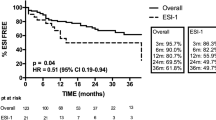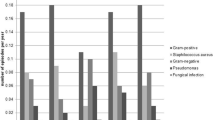Abstract
Background
The bacterial colonization of hemodialysis catheter occurs frequently and reaches to the catheter-related bloodstream infections (CRBSIs). We hypothesized bacterial colonization promotes inflammation and that might be associated with renal outcome. The aim of this study was to investigate the colonization status for tunneled cuffed dialysis catheter (TCC) and the factors for contributing to the catheter colonization and explore whether bacterial colonization would be related with declining of residual renal function (RRF).
Methods
115 patients who received TCC removal operation and underwent catheter tip culture from January 2005 to June 2014 were enrolled. The follow-up data such as urine output (UO), time to anuria and patients’ survival were collected from the patients or their family members by telephone in June, 2014.
Results
There were nineteen patients (16.5 %, 19/115) with positive tip culture (colonization group). In the analysis of demographic and biochemical parameters, there were no significant differences between both groups. Fifty of all the subjects responded to the telephone survey and ten patients (20.0 %, 10/50) belonged to colonization group. The monthly decreasing rate of UO was significantly more rapid in colonization group (p = 0.001). The survival analysis showed that colonization group had worse estimated anuria-free survival than non-colonization group (p < 0.001). In multivariate cox regression, bacterial colonization of TCC was an independent factor influencing the loss of RRF (HR 4.29, 95 % CI: 1.905–9.683, p ≤ 0.001).
Conclusions
Bacterial colonization of TCC was associated with rapid loss of RRF.

Similar content being viewed by others
References
Sabry AA, Elshafey EM, Alsaran K, Shalaby M, Alsherbeiny S, Abdelkader M. The level of C-reactive protein in chronic hemodialysis patients: a comparative study between patients with noninfected catheters and arteriovenous fistula in two large Gulf hemodialysis centers. Hemodial Int. 2014;18:674–9.
Goldstein SL, Ikizler TA, Zappitelli M, Silverstein DM, Ayus JC. Non-infected hemodialysis catheters are associated with increased inflammation compared to arteriovenous fistulas. Kidney Int. 2009;76:1063–9.
Pastan S, Soucie JM, McClellan WM. Vascular access and increased risk of death among hemodialysis patients. Kidney Int. 2002;62:620–6.
Thomson PC, Stirling CM, Geddes CC, Morris ST, Mactier RA. Vascular access in haemodialysis patients: a modifiable risk factor for bacteraemia and death. QJM. 2007;100:415–22.
Allon M, Daugirdas J, Depner TA, Greene T, Ornt D, Schwab SJ. Effect of change in vascular access on patient mortality in hemodialysis patients. Am J Kidney Dis. 2006;47:469–77.
Jin DC, Han JS. Renal replacement therapy in Korea, 2012. Kidney Res Clin Pract. 2014;33:9–18.
Collins AJ, Foley RN, Chavers B, Gilbertson D, Herzog C, Ishani A. US renal data system 2013 annual data report: Atlas of Chronic Kidney Disease and End-stage Renal Disease in the United States. National Institutes of Health, National Institute of Diabetes and Digestive and Kidney Diseases. 2014,2:216–228.
Goldstein S. Clinical practice guidelines for hemodialysis adequacy. Am J Kidney Dis. 2006;48(Suppl 1):S2–90.
Boyce JM. Prevention of central line–associated bloodstream infections in hemodialysis patients. Infect Control. 2012;33:936–44.
Dittmer I, Sharp D, McNulty C, Williams A, Banks R. A prospective study of central venous hemodialysis catheter colonization and peripheral bacteremia. Clin Nephrol. 1999;51:34–9.
Fux CA, Uehlinger D, Bodmer T, Droz S, Zellweger C, Mühlemann K. Dynamics of hemodialysis catheter colonization by coagulase-negative staphylococci. Infect Control. 2005;26:567–74.
Branas P, Morales E, Rios F, Sanz F, Gutierrez E, Quintanilla N, et al. Usefulness of endoluminal catheter colonization surveillance cultures to reduce catheter-related bloodstream infections in hemodialysis. Am J Infect Control. 2014;42:1182–7.
Raad I, Costerton W, Sabharwal U, Sacilowski M, Anaissie E, Bodey GP. Ultrastructural analysis of indwelling vascular catheters: a quantitative relationship between luminal colonization and duration of placement. J Infect Dis. 1993;168:400–7.
Hung A, Pupim L, Yu C, Shintani A, Siew E, Ayus C, et al. Determinants of C-reactive protein in chronic hemodialysis patients: relevance of dialysis catheter utilization. Hemodial Int. 2008;12:236–43.
Fontsere N, Cardozo C, Donate J, Soriano A, Muros M, Pons M, et al. Tunneled catheters with taurolidine-citrate-heparin lock solution significantly improve the inflammatory profile of hemodialysis patients. Antimicrob Agents Chemother. 2014;58:4180–4.
Libby P, Okamoto Y, Rocha VZ, Folco E. Inflammation in Atherosclerosis. Circ J. 2010;74:213–20.
Raimann JG, Kitzler TM, Levin NW. Factors affecting loss of residual renal function(s) in dialysis. Contrib Nephrol. 2012;178:150–6.
Ceballos-Picot I, Witko-Sarsat V, Merad-Boudia M, Nguyen AT, Thevenin M, Jaudon MC, et al. Glutathione antioxidant system as a marker of oxidative stress in chronic renal failure. Free Radic Biol Med. 1996;21:845–53.
Kato S, Chmielewski M, Honda H, Pecoits-Filho R, Matsuo S, Yuzawa Y, et al. Aspects of immune dysfunction in end-stage renal disease. Clin J Am Soc Nephrol. 2008;3:1526–33.
Kim HW, Woo YS, Yang HN, Choi HM, Jo SK, Cho WY, et al. Primed monocytes: putative culprits of chronic low-grade inflammation and impaired innate immune responses in patients on hemodialysis. Clin Exp Nephrol. 2011;15:258–63.
Nguyen-Khoa T, Massy ZA, De Bandt JP, Kebede M, Salama L, Lambrey G, et al. Oxidative stress and haemodialysis: role of inflammation and duration of dialysis treatment. Nephrol Dial Transpl. 2001;16:335–40.
Stenvinkel P, Carrero JJ, Axelsson J, Lindholm B, Heimburger O, Massy Z. Emerging biomarkers for evaluating cardiovascular risk in the chronic kidney disease patient: how do new pieces fit into the uremic puzzle? Clin J Am Soc Nephrol. 2008;3:505–21.
Suresh DR, Silvia CRWD, Agarwal R. Biochemical markers of oxidative stress in predialytic chronic renal failure patients. Hong Kong J Nephrol. 2008;10:69–73.
Honda H, Qureshi AR, Heimburger O, Barany P, Wang K, Pecoits-Filho R, et al. Serum albumin, C-reactive protein, interleukin 6, and fetuin a as predictors of malnutrition, cardiovascular disease, and mortality in patients with ESRD. Am J Kidney Dis. 2006;47:139–48.
Menon V, Wang X, Greene T, Beck GJ, Kusek JW, Marcovina SM, et al. Relationship between C-reactive protein, albumin, and cardiovascular disease in patients with chronic kidney disease. Am J Kidney Dis. 2003;42:44–52.
McIntyre CW. Recurrent circulatory stress: the dark side of dialysis. Semin Dial. 2010;23:449–51.
Lim WH, Kireta S, Leedham E, Russ GR, Coates PT. Uremia impairs monocyte and monocyte-derived dendritic cell function in hemodialysis patients. Kidney Int. 2007;72:1138–48.
Verkade MA, van Druningen CJ, Vaessen LM, Hesselink DA, Weimar W, Betjes MG. Functional impairment of monocyte-derived dendritic cells in patients with severe chronic kidney disease. Nephrol Dial Transpl. 2007;22:128–38.
Anding K, Gross P, Rost JM, Allgaier D, Jacobs E. The influence of uraemia and haemodialysis on neutrophil phagocytosis and antimicrobial killing. Nephrol Dial Transpl. 2003;18:2067–73.
Shemin D, Bostom AG, Laliberty P, Dworkin LD. Residual renal function and mortality risk in hemodialysis patients. Am J Kidney Dis. 2001;38:85–90.
Bargman JM, Golper TA. The importance of residual renal function for patients on dialysis. Nephrol Dial Transpl. 2005;20:671–3.
Thomas J, Teitelbaum I. Preservation of residual renal function in dialysis patients. Adv Perit Dial. 2011;27:112–7.
Kim YB, Lee DW, An SJ, Jung YS, Lee SB, Kwak IS, et al. A study of central venous hemodialysis catheter colonization and peripheral bacteremia in patients undergoing hemodialysis. Korean J Med. 2001;61:121–6.
Saad TF. Bacteremia associated with tunneled, cuffed hemodialysis catheters. Am J Kidney Dis. 1999;34:1114–24.
Krishnasami Z, Carlton D, Bimbo L, Taylor ME, Balkovetz DF, Barker J, et al. Management of hemodialysis catheter-related bacteremia with an adjunctive antibiotic lock solution. Kidney Int. 2002;61:1136–42.
Solomon LR, Cheesbrough JS, Ebah L, Al-Sayed T, Heap M, Millband N, et al. A randomized double-blind controlled trial of taurolidine-citrate catheter locks for the prevention of bacteremia in patients treated with hemodialysis. Am J Kidney Dis. 2010;55:1060–8.
Power A, Duncan N, Singh SK, Brown W, Dalby E, Edwards C, et al. Sodium citrate versus heparin catheter locks for cuffed central venous catheters: a single-center randomized controlled trial. Am J Kidney Dis. 2009;53:1034–41.
Jean G, Charra B, Chazot C, Vanel T, Terrat JC, Hurot JM, et al. Risk factor analysis for long-term tunneled dialysis catheter-related bacteremias. Nephron. 2002;91:399–405.
de Freitas LW, Neto MM, Nascimento MM, Figueiredo JF. Bacterial colonization in hemodialysis temporary dual lumen catheters: a prospective study. Ren Fail. 2008;30:31–5.
Kairaitis LK, Gottlieb T. Outcome and complications of temporary haemodialysis catheters. Nephrol Dial Transpl. 1999;14:1710–4.
Iseki K, Tozawa M, Yoshi S, Fukiyama K. Serum C-reactive protein (CRP) and risk of death in chronic dialysis patients. Nephrol Dial Transpl. 1999;14:1956–60.
Schwab SJ, Beathard G. The hemodialysis catheter conundrum: hate living with them, but can’t live without them. Kidney Int. 1999;56:1–17.
Toor MR, Singla A, Kim JK, Sumin X, DeVita MV, Michelis MF. Preventing the progression of chronic kidney disease: two case reports and review of the literature. Int Urol Nephrol. 2014;46:2167–74.
O’Grady NP, Alexander M, Dellinger EP, Gerberding JL, Heard SO, Maki DG, et al. Guidelines for the prevention of intravascular catheter–related infections. Clin Infect Dis. 2002;35:1281–307.
Patel PR, Yi SH, Booth S, Bren V, Downham G, Hess S, et al. Bloodstream infection rates in outpatient hemodialysis facilities participating in a collaborative prevention effort: a quality improvement report. Am J Kidney Dis. 2013;62:322–30.
Allon M. Dialysis catheter-related bacteremia: treatment and prophylaxis. Am J Kidney Dis. 2004;44:779–91.
Allon M. Prophylaxis against dialysis catheter-related bacteremia with a novel antimicrobial lock solution. Clin Infect Dis. 2003;36:1539–44.
Onder AM, Chandar J, Billings A, Simon N, Gonzalez J, Francoeur D, et al. Prophylaxis of catheter-related bacteremia using tissue plasminogen activator-tobramycin locks. Pediatr Nephrol. 2009;24:2233–43.
Venditto M, Du Montcel ST, Robert J, Trystam D, Dighiero J, Hue D, et al. Effect of catheter-lock solutions on catheter-related infection and inflammatory syndrome in hemodialysis patients: heparin versus citrate 46 % versus heparin/gentamicin. Blood Purif. 2010;29:268–73.
Justo JA, Bookstaver PB. Antibiotic lock therapy: review of technique and logistical challenges. Infect Drug Resist. 2014;7:343–63.
Author information
Authors and Affiliations
Corresponding author
Ethics declarations
Conflict of interest
None.
About this article
Cite this article
Kang, J.S., Jang, H.R., Lee, J.E. et al. The bacterial colonization in tunneled cuffed dialysis catheter and its effects on residual renal function in incident hemodialysis patients. Clin Exp Nephrol 20, 294–301 (2016). https://doi.org/10.1007/s10157-015-1148-5
Received:
Accepted:
Published:
Issue Date:
DOI: https://doi.org/10.1007/s10157-015-1148-5




